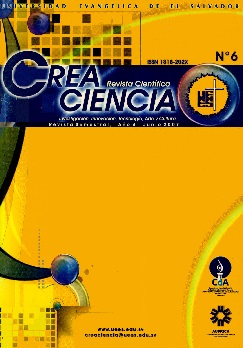Outbreak of Food Poisoning by Salmonella Enteritidis at Zacamil National Hospital March 2007
DOI:
https://doi.org/10.5377/creaciencia.v0i6.8601Keywords:
Outbreak, Food poisoning, Salmonella enteritidisAbstract
Between March 4 and 5, 2007, at the Zacarnil Hospital. an outbreak of 37 people with acute gastroenteritis who had participated in a family party were treated, 24 patients were treated, of which 16 were hospitalized The absence of an etiologic agent and the number of patients who consulted with the same clinical picture, and that all They came from the same place presents a challenge to research. The type of study was an observational retrospective cohort. Inclusion criteria: hospitalized patients who met the proposed case definition. Demographic, clinical and faecal samples were collected. Once the causative agent was identified, confirmatory stool samples were sent to the Central Max Bloch laboratory in San Salvador. Overall attack rates, clinical attack rate, co-culture confirmed case attack rate, and food attack rate were calculated. Data capture in Epi Info and Excel package. Among the results it was obtained that the highest food attack rate (100%) was for polio sandwich, 100% global attack house, 64% clinical attack rate, co-culture confirmed case attack rate of 100 %, detention rate of 66%. The pathogen that was isolated corresponded to Salmonella sp Poly AI-N Group D1, in 100% of the faecal samples. Greater confirmation (phage topaz) showed the presence of Salmonella Group D1, factors I, 9 and 12 in 100%. It was concluded that the outbreak was due to Salmonella enteritidis 9.12 gmfagotype 1; The results suggest a common source outbreak.
Downloads
707
Downloads
Published
How to Cite
Issue
Section
License
© Crea Ciencia
Declaration of originality and assignment of rights
The article must be sent with a declaration of originality, responsibility and assignment of rights of copy of the manuscript, scanned and signed by the author or by one of the authors when the authorship is collective (designated author), stating that the text has not previously published in printed or electronic format, which will not be presented to any other media before knowing the decision of the journal Crea Ciencia and that, if accepted for publication, the authors transfer the copyrights in all forms and media known. At the end of six months of the publication, the text can be shared in another magazine citing the first version of the article published in Crea Ciencia and recording its number and volume. If the article is not published, the UEES agrees to return the rights enunciated to their authors.

Crea Ciencia articles are published in open access and licensed under a Creative Commons Attribution-NonCommercial 4.0 International License.

